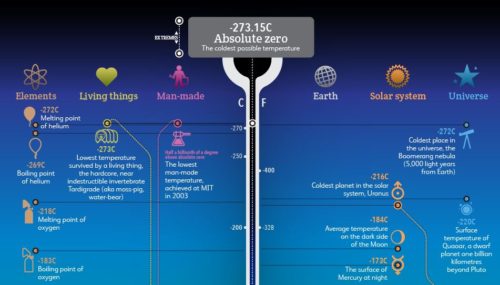Ik kwam op de website van de BBC een interessante infographic tegen, waarin de temperatuur van een groot aantal objecten op schaal wordt weergegeven. De schaal begint bij het absolute nulpunt, iets meer dan -273 graden Celsius, en eindigt bij de absolute maximumtemperatuur – zodra het heter wordt dan deze temperatuur, worden de natuurwetten doorbroken en kan de natuurkunde overboord. Tussen die twee uitersten zie je ondermeer de temperatuur van lava, de kern van de zon én de hoogste temperatuur die ooit door mensen bereikt is – dubbelklikken voor de grote versie.
Wat is volgens de natuurkunde de laagste én hoogste mogelijke temperatuur?
12 januari 2015 door 7 Reacties





De hoogste temperatuur zal dan wel de temperatuur van de hel zijn.
In ben niet helemaal op de hoogte van godsdienstige zaken, maar volgens mij zijn de omstandigheden in de Hel die van het triple punt van Zwavel(S)… zo’n beetje 386 K (~113° C )
🙂
—-
In het diagram mis ik wel een beetje de temperatuur van de achtergrondstraling… op ca. 3 K .
—-
De maximum temperatuur? 😕
Als je stoffen / gassen verwarmt, gaan de moleculen sneller bewegen….
maar uiteindelijk zit daar een maximum aan : c
Ruim voor die snelheid zullen meer-atomige moleculen al uiteen vallen in atomen of hun ionen(geladen atomen).
Als ik me niet vergis heet die aggregatietoestand : Plasma.
De delen in de plasma kunnen natuurlijk weer verder verwarmd / versneld worden (max. tot c).
Groet, Paul
ja en in de hemel hebben we het licht van zeven zonnen die ieder zeven keer zo helder schijnen als onze zon. Uitgaande van een aardse atmosfeer in de hemel, zou de temperatuur daarmee boven de 3000 C komen.
Je kan dus beter naar de hel dan naar de hemel.
: rec.humor.funny, Feb 28, 1997
Is hell endothermic or exothermic?
No idea where this originated from. All previous forward headers had been removed before it got to me. Sorry if it’s copyrighted, but…..
Physics of Hell
A true story. A thermodynamics professor had written a take home exam for his graduate students. It had one question:
“Is hell exothermic or endothermic? Support your answer with a proof.”
Most of the students wrote proofs of their beliefs using Boyle’s Law or some variant. One student, however wrote the following:
First, we postulate that if souls exist, then they must have some mass.
If they do, then a mole of souls can also have a mass. So, at what rate are souls moving into hell and at what rate are souls leaving? I think that we can safely assume that once a soul gets to hell, it will not leave. Therefore, no souls are leaving.
As for souls entering hell, lets look at the different religions that exist in the world today. Some of these religions state that if you are not a member of their religion, you will go to hell. Since, there are more than one of these religions and people do not belong to more than one religion, we can project that all people and all souls go to hell.
With birth and death rates as they are, we can expect the number of souls in hell to increase exponentially.
Now, we look at the rate of change in volume in hell. Boyle’s Law states that in order for the temperature and pressure in hell to stay the same, the ratio of the mass of souls and volume needs to stay constant.
So, if hell is expanding at a slower rate than the rate at which souls enter hell, then the temperature and pressure in hell will increase until all hell breaks loose.
Of course, if hell is expanding at a rate faster than the increase of souls in hell, than the temperature and pressure will drop until hell freezes over.
lol 😉
Hij is leuk! 🙂
groet,
Gert (Enceladus)
Ik heb ooit in een vlaag van vermoedelijk verstandsverbijstering geroepen dat die minimum temperatuur en maximum temperatuur uiteindelijk bij hetzelfde uitkomen, dat ze verwant zijn aan elkaar.